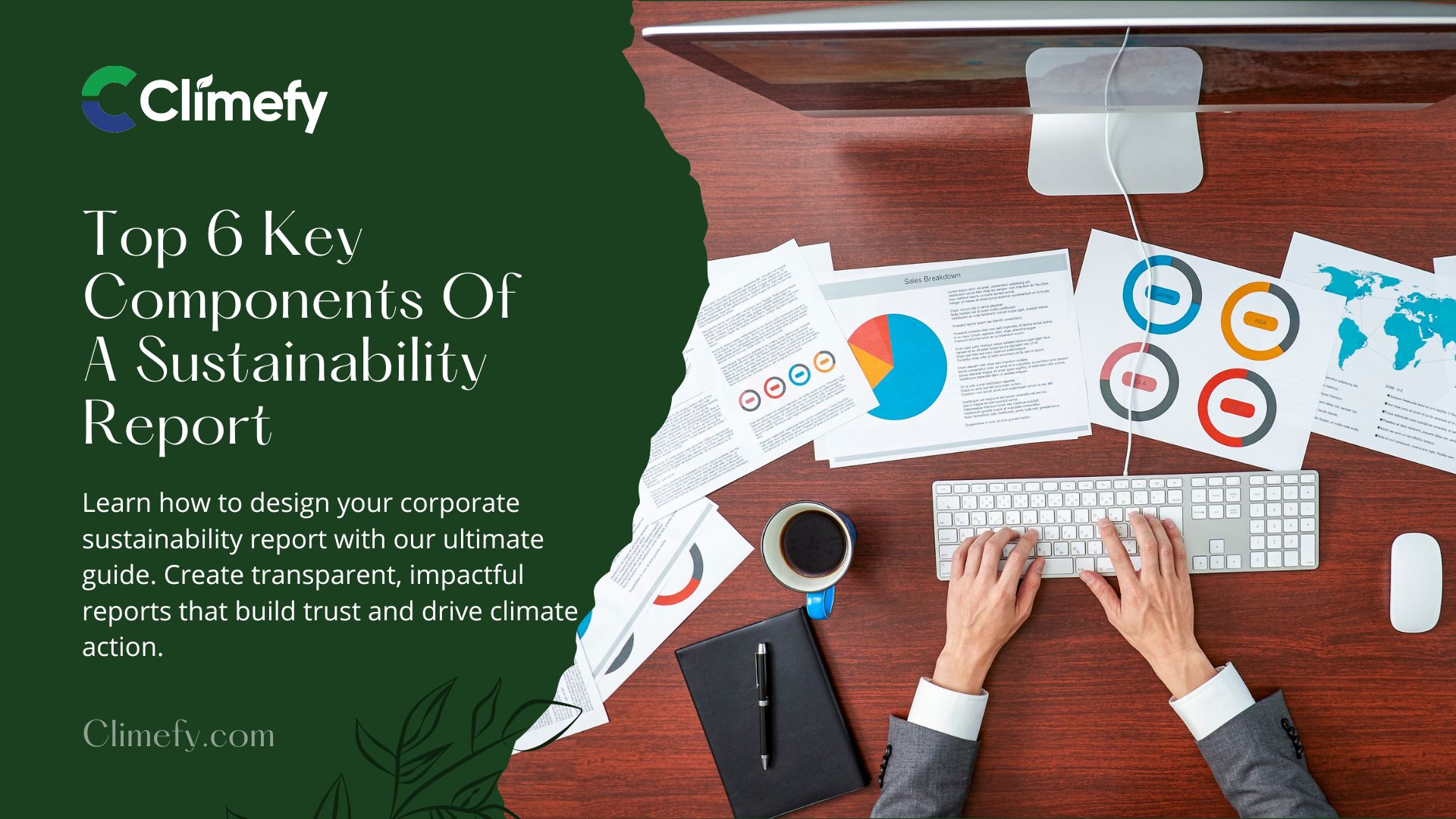

A comprehensive sustainability report is a cornerstone of modern corporate transparency, detailing a company’s environmental, social, and governance (ESG) performance. This ultimate guide will deconstruct the essential elements required to produce a credible and impactful document that meets stakeholder expectations and regulatory demands. You will learn the foundational pillars that transform raw data into a compelling narrative of your organization’s commitment to sustainable development and responsible business practices.
In this definitive guide, you will learn:
Read More:
![Top 6 Key Components Of A Sustainability Report [Ultimate Guide] 1 Top-6-Key-Components-Of-A-Sustainability-Report-Ultimate-Guide](https://climefy.com/wp-content/uploads/2025/11/Top-6-Key-Components-Of-A-Sustainability-Report-Ultimate-Guide-1024x576.jpg)
A sustainability report, also referred to as an ESG report (Environmental, Social, and Governance) or corporate social responsibility (CSR) report, is a published document that details an organization’s economic, environmental, and social impacts resulting from its everyday activities.
It fundamentally serves as a tool for transparent sustainability communication, allowing a company to publicly disclose its performance, positive and negative impacts, and its contributions toward the UN Sustainable Development Goals (SDGs).
In today’s business landscape, it has evolved from a niche public relations exercise into a strategic imperative for risk management, investor relations, and maintaining a competitive advantage. A well-crafted report demonstrates a commitment to corporate accountability and stakeholder engagement, providing a clear window into the company’s long-term viability and ethical compass.
The value of a robust sustainability reporting framework extends far beyond compliance. It is a powerful instrument for:
To begin this journey, organizations must first understand their baseline impact. Utilizing a robust carbon footprint calculator is an essential first step in quantifying environmental impact, a process that companies like Climefy facilitate through advanced digital tools for businesses of all sizes.
The first and most critical component of any credible sustainability report is the conduct of a thorough materiality assessment. This process is the foundational step in sustainability accounting and reporting, as it determines which environmental, social, and governance (ESG) issues are most significant to the business and its key stakeholders.
The outcome of a materiality assessment is a prioritized list of material topics—the issues that truly matter and warrant detailed disclosure in the report. Without this focused approach, reports can become unfocused collections of data, lacking strategic direction and failing to address the core concerns of readers and stakeholders.
A proper assessment ensures that the sustainability disclosure is relevant, concise, and truly reflective of the organization’s most significant impacts.
The process of stakeholder engagement is intrinsically linked to the materiality assessment. It involves systematically identifying and consulting with groups who are affected by or can affect the organization’s activities.
Key steps in a robust materiality assessment process include:
This rigorous process ensures that the subsequent sections of the sustainability report are aligned with what is genuinely important, making the document a strategic tool rather than just a marketing brochure. For companies embarking on this journey, expert ESG consultancy services can provide the necessary guidance to navigate this complex but vital first step effectively.
The leadership statement and organizational profile sections set the stage for the entire sustainability report. They provide the context, tone, and strategic framing that help readers understand the “why” behind the data.
A statement from the highest level of leadership, such as the CEO or Board Chair, is not merely an introduction; it is a powerful demonstration of top-level commitment to corporate sustainability and ESG integration. This section should articulate the company’s vision, acknowledge challenges, and express a genuine commitment to continuous improvement.
Meanwhile, the organizational profile offers a snapshot of the company—its size, structure, markets, and operational context—which is essential for stakeholders to accurately interpret the performance data presented later in the report.
A powerful leadership statement should move beyond generic platitudes and instead offer:
The organizational profile, while more factual, is equally critical for transparency and should include:
This combination of visionary leadership communication and clear, factual organizational context builds immediate credibility and provides the necessary framework for the detailed performance disclosures that follow. It signals that sustainability is not a side project but is embedded in the core of the business.
The environmental dimension of a sustainability report is often the most data-intensive and is critical for demonstrating a company’s commitment to mitigating its ecological footprint. This section requires the transparent disclosure of quantitative metrics related to the company’s resource use, emissions, and overall environmental impact.
Reporting on these environmental indicators is fundamental for assessing a company’s contribution to climate change and its dependence on natural capital. Comprehensive disclosure in this area allows investors, regulators, and customers to evaluate environmental performance, track progress over time, and compare companies within the same sector.
Adherence to recognized frameworks like the Greenhouse Gas (GHG) Protocol is essential for ensuring consistency and credibility.
The core environmental indicators that must be included revolve around energy, emissions, water, waste, and biodiversity.
Essential environmental metrics for disclosure include:
Accurately calculating Scope 3 emissions can be particularly complex. Tools like the carbon calculator for large organizations offered by Climefy can be instrumental in managing this extensive data, enabling precise tracking and reporting to meet ambitious corporate sustainability goals.
The social component of a sustainability report addresses the company’s impacts on people—both inside and outside the organization. This encompasses a wide range of topics related to labor practices, human rights, community engagement, and product responsibility.
Transparent reporting on social performance is non-negotiable because it directly reflects the company’s culture, ethics, and social license to operate. It provides critical insights into how the company treats its workforce, ensures safe working conditions, fosters diversity and inclusion, and contributes positively to the communities in which it operates.
In an era of heightened social consciousness, robust social performance disclosure is a key determinant of employer branding, customer loyalty, and overall corporate reputation.
This section demonstrates a company’s commitment to its human capital and societal obligations.
Key social performance indicators to disclose include:
Beyond internal metrics, social performance extends to the supply chain. Companies are increasingly expected to report on their supplier code of conduct and the steps taken to ensure ethical sourcing and labor practices throughout their value chain. Demonstrating a commitment to being an eco-friendly partner often involves not just environmental criteria but also social standards for suppliers, ensuring a holistic approach to sustainability.
The governance component of a sustainability report is the backbone that ensures the integrity and accountability of all other disclosures. It outlines the structures, processes, and controls that the company has in place to oversee ESG issues, manage risks, and ensure ethical conduct throughout the organization.
Without strong governance disclosures, stakeholders may question the reliability of the environmental and social performance data presented.
This section demonstrates how sustainability is embedded at the highest levels of decision-making, showing that it is not an ancillary function but a core business concern subject to rigorous oversight and management. It addresses the “G” in ESG, which is increasingly a primary focus for investors assessing long-term risk.
Effective governance reporting provides transparency into the board’s role and the company’s ethical framework.
Critical elements of governance disclosure include:
This governance structure is what gives investors and other stakeholders confidence that the company is managed with integrity and is prepared for the long term. For many organizations, leveraging digital integration solutions can streamline the governance process, providing real-time data dashboards for the board and ensuring that sustainability metrics are integrated into mainstream business reporting seamlessly.
The final critical component of a sustainability report is the forward-looking section on goals, targets, and future strategy. While reporting on past performance is essential, stakeholders are equally, if not more, interested in where the company is headed.
This section translates the current state of performance into a roadmap for future action and ambition. It demonstrates a commitment to continuous improvement and provides a measurable benchmark against which the company can be held accountable in subsequent reporting cycles.
Setting science-based targets, particularly for carbon reduction, has become a gold standard, aligning corporate goals with the global effort to limit climate change as outlined in the Paris Agreement.
A robust goals and targets section should be specific, measurable, and time-bound.
Best practices for disclosing sustainability goals and strategy include:
This future-oriented section closes the loop on the sustainability reporting cycle, showing that the company is not just accounting for the past but is strategically planning for a more sustainable and resilient future.
For organizations looking to turn ambition into action, accessing a verified marketplace for high-impact carbon reduction projects is a crucial step in neutralizing unavoidable emissions and contributing to global climate action while on their decarbonization journey.
While the terms are often used interchangeably, there is a subtle distinction. A sustainability report traditionally takes a broader view, focusing on a company’s overall impact on the economy, environment, and society. An ESG report is often more focused on the specific environmental, social, and governance criteria that are financially material to investors. In practice, modern sustainability reports have largely evolved to encompass all material ESG factors.
There is no single “best” framework; the choice depends on your industry, location, and stakeholder expectations. The most widely adopted global standards are the Global Reporting Initiative (GRI) Standards, which are comprehensive and suitable for all organizations. For climate-specific disclosures, the Task Force on Climate-related Financial Disclosures (TCFD) recommendations are the benchmark. For investor-focused reporting, the Sustainability Accounting Standards Board (SASB) standards (now part of the IFRS Foundation’s ISSB) provide industry-specific guidance. Many companies now use an integrated approach, combining elements from several frameworks.
The regulatory landscape is rapidly evolving. While sustainability reporting has historically been voluntary, it is becoming mandatory in many jurisdictions. The European Union’s Corporate Sustainability Reporting Directive (CSRD) is a prime example, requiring extensive reporting from a wide range of companies. Similarly, the SEC in the US has proposed climate disclosure rules. Even where not yet mandatory, it is considered a standard business practice for any company of significant size.
SMEs should start small and focus on materiality. Begin by using a dedicated carbon calculator for small & medium companies to understand your carbon footprint. Then, engage with your key stakeholders—employees, customers, local community—to identify their top concerns. Focus on collecting data for a few key performance indicators (KPIs) related to energy, waste, and employee well-being. You do not need a 100-page report; a concise, honest communication on your website or a short PDF can be an excellent first step.
Third-party assurance, similar to a financial audit, involves an independent external party verifying the accuracy and reliability of the information in your sustainability report. While not always mandatory, it greatly enhances the report’s credibility and trustworthiness. It signals to stakeholders that the company is serious about transparency and that its data can be trusted.